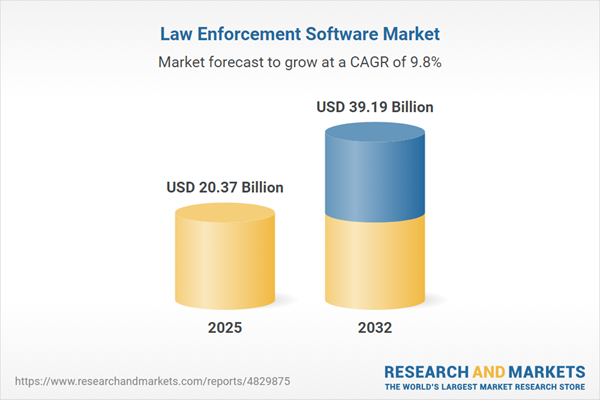Speak directly to the analyst to clarify any post sales queries you may have.
The law enforcement software market is undergoing significant transformation, driven by operational needs, advanced digital integration, and rapid technological progress. Senior decision-makers face a dynamic landscape requiring a balance between innovation and operational resilience.
Market Snapshot: Law Enforcement Software Market Overview
The law enforcement software market grew from USD 18.55 billion in 2024 to USD 20.37 billion in 2025 and is forecast to reach USD 39.19 billion by 2032, registering a CAGR of 9.80%.
Scope & Segmentation
This comprehensive report analyzes the evolving law enforcement software landscape across essential components, deployment models, agency sizes, end-users, regions, and technology drivers, with detailed segmentation to guide strategic planning:
- Components: Services such as consultation, system integration, and managed support; software solutions including case management, computer-aided dispatch, digital policing, incident response, jail management, and record management.
- Deployment Models: Cloud-based solutions, on-premises systems, and emerging hybrid approaches to meet varied operational and regulatory needs.
- Agency Sizes: Large agencies with complex requirements; medium agencies balancing function and cost; small agencies prioritizing simplicity and vendor-managed services.
- End-User Categories: Correctional facilities, federal and state agencies, law enforcement organizations, municipalities, and police departments, each with distinct workflow priorities.
- Regions: The Americas (North America, Latin America), Europe, the Middle East, Africa, and Asia-Pacific, supporting localized procurement and compliance strategies.
- Technology Enablers: Integration of artificial intelligence, machine learning, mobile connectivity, and cloud architectures that facilitate scalable, data-driven policing and improved field capabilities.
- Key Companies: In-depth profiles on providers such as 365Labs, LLC, Accenture PLC, Axon Enterprise, Inc., Cellebrite DI Ltd., Diverse Computing, Inc., IBM Corporation, Hexagon AB, and others.
Key Takeaways for Senior Decision-Makers
- Unified software platforms are increasingly replacing siloed legacy systems, enabling agencies to integrate big data analytics, predictive insights, and real-time intelligence into everyday workflows.
- The convergence of mobile-first tools and cloud-native deployments increases operational agility and ensures secure, scalable access to critical information in the field.
- Stakeholder demand for transparency, accountability, and streamlined citizen engagement is reshaping solution priorities, requiring flexible architectures and adaptive reporting tools.
- Vendor strategies now emphasize open-architecture frameworks that support third-party sensor integration, unmanned systems, and future modular enhancements with minimal disruption.
- Differences in regional regulatory environments and infrastructure maturity highlight the importance of localized support, compliance modules, and language options for global deployments.
- Procurement teams are forming purchasing consortia to secure standardized, cost-effective solutions and maximize budget efficiency across jurisdictions.
Impact of 2025 United States Tariffs on Procurement & Operating Models
In 2025, changes to the United States tariff structure influenced procurement strategies. Hardware costs have required agencies to review capital forecasts and seek new supplier agreements. These pressures accelerated migration to virtualized and cloud environments, reducing dependency on physical imports. Collaborative sourcing and vendor-optimized code have enabled agencies to mitigate cost burdens, supporting lean IT operations and strategic continuity.
Methodology & Data Sources
This market analysis draws upon robust secondary research—including public documents, regulatory reports, vendor materials, and white papers—supplemented by detailed interviews with IT leaders and procurement experts from various agency sizes and regions. Data integrity is reinforced through cross-referencing, stakeholder surveys, and benchmarking with industry trends, adhering to strict ethical and confidentiality standards throughout.
Why This Report Matters
- Gain actionable intelligence to inform strategic procurement and technology investment decisions in a rapidly evolving regulatory and threat environment.
- Understand market dynamics, deployment models, and segmentation to better align technology initiatives with operational and compliance priorities across regions and agency types.
- Leverage competitive and regional insights to foster innovation, optimize resource allocation, and strengthen organizational resilience in law enforcement operations.
Conclusion
In a continually shifting landscape, adaptive law enforcement software enables agencies to optimize workflows and reinforce public trust. Strategic adoption of open, modular platforms supports operational excellence and future-readiness in the face of evolving security and technology demands.
Additional Product Information:
- Purchase of this report includes 1 year online access with quarterly updates.
- This report can be updated on request. Please contact our Customer Experience team using the Ask a Question widget on our website.
Table of Contents
3. Executive Summary
4. Market Overview
7. Cumulative Impact of Artificial Intelligence 2025
Companies Mentioned
The companies profiled in this Law Enforcement Software market report include:- 365Labs, LLC
- Accenture PLC
- Axon Enterprise, Inc.
- CAPERS North America, LLC
- Cellebrite DI Ltd.
- CODY Systems
- Cyrun
- Diverse Computing, Inc.
- ESRI
- GovPilot, LLC
- Haystax by Fishtech LLC Company
- Hexagon AB
- Incident Response Technologies, Inc.
- International Business Machines Corporation
- Julota
Table Information
| Report Attribute | Details |
|---|---|
| No. of Pages | 198 |
| Published | November 2025 |
| Forecast Period | 2025 - 2032 |
| Estimated Market Value ( USD | $ 20.37 Billion |
| Forecasted Market Value ( USD | $ 39.19 Billion |
| Compound Annual Growth Rate | 9.8% |
| Regions Covered | Global |
| No. of Companies Mentioned | 16 |









